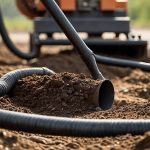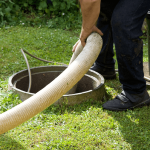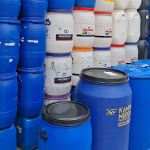Septic SOS: Spotting the Silent Saboteurs in Your Septic System Maintenance
In rural areas like the Clarence Valley, septic system maintenance is essential for managing household wastewater, and while they’re usually out of sight and out of mind, septic system problems can develop quietly and cause serious issues if left unattended to.
Knowing what to look for and how to care for your system can help you to avoid these silent saboteurs before they strike, and with the right preventative steps and timely attention, homeowners can ensure that their systems are operating correctly and problem-free for years to come.
Identifying Septic System Maintenance Early
Recognising the early signs of septic system maintenance is important. These warning signs often start small and worsen over time, so addressing them early can help to prevent major damage and costs.
- Slow Drains: If your sinks or bathtubs are draining slowly, it could mean that your septic system is becoming blocked or overloaded. Frequent backups in toilets are another strong indicator that the system is struggling.
- Gurgling Noises: Strange sounds from your plumbing may indicate trapped air due to a blockage or system imbalance. These noises are easy to dismiss but shouldn’t be ignored.
- Bad Odours: Persistent sewage smells around your home, especially near the drain field or tank, are often a sign that untreated waste is escaping.
- Pooling Water: Standing water in your yard, particularly near the septic tank or drain field, can be an indicator that the soil is saturated, and that the system is failing.
Acting when these signs first appear can help to avoid septic system failure and protect both your property and your family’s health.
Understanding the Causes of Septic System Maintenance
Septic system failure can occur for a number of reasons, many of which are preventable through daily habits and regular maintenance.
- Overloading the System: Using too much water at once, such as running multiple appliances or long showers, can overwhelm the system, causing solids to reach the drain field.
- Flushing Inappropriate Items: Wipes, sanitary products, grease, coffee grounds, and household chemicals can clog pipes and disturb the microbial balance within the tank. Even products labelled as “flushable” should be avoided.
- A Lack of Maintenance: Without routine pumping, solids accumulate and reduce the tank’s capacity. This often results in blockages or untreated wastewater escaping into the environment.
- Root and Structural Damage: Tree roots can infiltrate underground systems in search of moisture, cracking or block pipes, while parking vehicles or heavy machinery above the system may cause structural damage.
Understanding these common causes of septic system failure helps homeowners take preventive action before the problems become significant.
Preventative Maintenance Tips
Routine care is the key to your septic system functioning efficiently and avoiding sudden failure. Fortunately, most maintenance tasks are straightforward and affordable.
- Pump the Tank Regularly: Every 3–5 years, your tank should be pumped by a licensed contractor to remove solids and prevent clogging. How often pumping is needed varies based on the size of the household and how much water is used.
- Use Water Efficiently: High water use is a common contributor to septic stress. Install water-saving taps, toilets, and appliances, and repair leaks quickly to reduce the volume going into the system.
- Be Careful What You Flush: Only toilet tissue and human waste should be disposed of through the system. Grease, paint, medicine, and harsh cleaners can interfere with the system’s ability to treat waste properly.
- Protect the Drain Field: Never drive or build on top of the drain field. Keep trees at least several metres away to avoid root intrusion, and direct gutters and stormwater away from the area.
- Schedule Regular Inspections: A professional can assess your system’s condition, identify early warning signs, and recommend the right time for pumping.
These steps can extend the life of your septic system, helping you to avoid the expense of emergency repairs.
The Environmental Impact of Septic System Failure
When septic systems fail, the effects go beyond just your backyard. Poorly maintained systems can spread bacteria, viruses, and nutrients like nitrogen and phosphorus into waterways, leading to health concerns and environmental damage. Contaminated water can leak into nearby soil, creeks, and groundwater sources, putting the public and the environment at risk. Algae blooms caused by excess nutrients can suffocate aquatic life and make water bodies unsafe for recreation or drinking. Therefore, maintaining your septic system is a key part of being a responsible landowner and protecting the wider ecosystem.
Septic Systems and Their Maintentance
Septic systems are an important part of everyday life in rural Australia and maintaining their upkeep requires a proactive approach. Spotting signs like slow drains, bad smells, and standing water can help you act before minor septic system problems turn into a full-scale failure.
Understanding the common causes – from overuse to poor waste disposal – and performing regular maintenance such as pumping and inspections can keep your system running smoothly for decades, and a well-maintained septic system not only protects your home but also safeguards your local environment.
If you’ve noticed any signs of septic system failure or haven’t had your system checked in several years, now is the time to act. At Clarence Valley Septics we offer expert inspections, pumping, and maintenance services.
Our team is here to help keep your system functioning reliably and safely. Don’t wait for problems to surface – contact us today on +61 2 6645 3100 or via our website for professional, local support.


